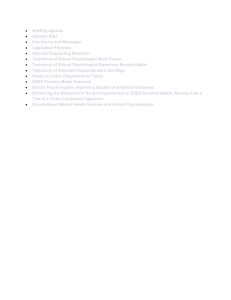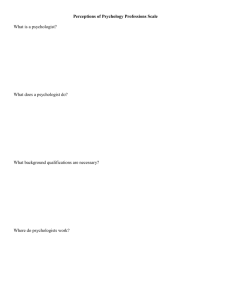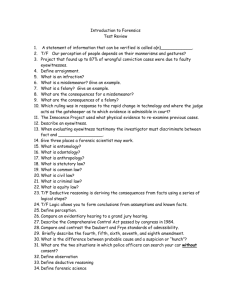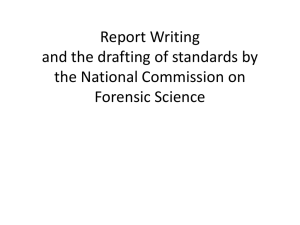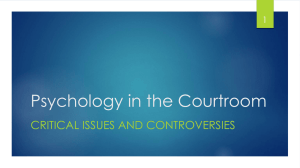Psychology in Court
advertisement
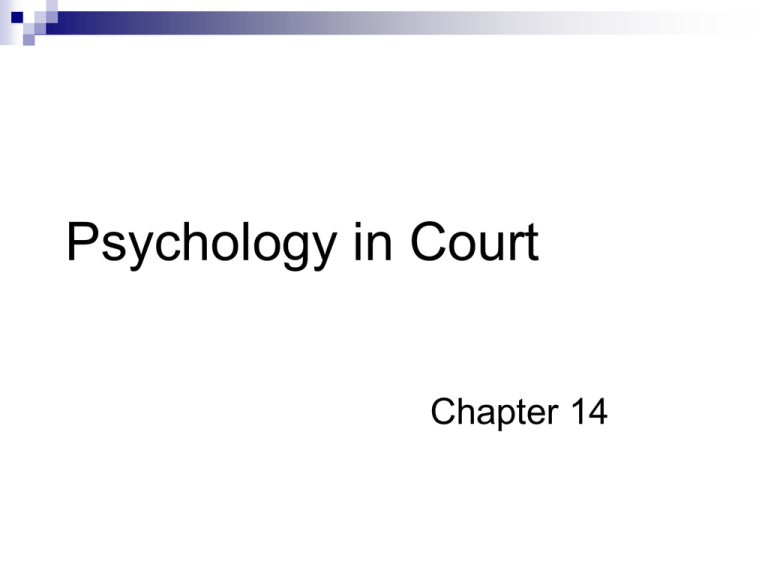
Psychology in Court Chapter 14 A Brief History Cattell (1895) Questions about everyday observations and the nature of testimony Binet (1900) Suggestibility Stern The in children (1910) eyewitness ‘reality experiment’ Psychologists in Court Von Schrenck-Notzing (1896) First forensic psychologist in literal form German expert witness in serial sexual murder case Extensive pre-trial press coverage Retroactive memory falsification What was seen versus what was heard Forensic Psychology in North America Munsterberg (1908) On the Witness Stand Psychology and the legal system Resistance from legal scholars Pushed psychology into legal arena Father of forensic psychology Forensic Psychology in North America Legal cases in U.S. address admissibility of ‘expert testimony’ Influence of Jenkins v. United States (1962) Dealt with whether psychologists should be allowed to provide expert testimony on issues of mental illness U.S. Supreme Court decided that some psychologists are qualified to provide such testimony U.S. Decisions Regulate Scientific Expertise Frye v. United States Standard of general acceptance of scientific principle or discovery Daubert Set v. Merrell Dow Pharmaceuticals out new rules to consider in evaluating novel scientific evidence Emphasis on the validity of the science behind the testimony Experts should back up what they say by citing and explaining relevant findings Big problems for psychology and psychiatry Admissibility of Expert Testimony Daubert Criteria Be provided by a qualified person Be relevant Be reliable Peer reviewed Testable Recognized rate of error Meet professional standards Seeking to Introduce “novel” expert evidence Father accused of sexually assaulting his two children Defense attempted to introduce a psychiatrist who would give the opinion that the accused did not possess deviant personality traits Based his opinion on a PPG Judge excluded evidence (no standard profile established; necessity & relevance criteria not met) WHY???????????? Court found technique generally recognized by scientific community as a therapeutic tool but first time as a forensic tool (novel purpose) Closeness of opinion to issue – if evidence accepted, it would exclude accused from group of potential offenders Relevant & necessary – tests not reliable nor applicable (<50% dectected) Cost benefit – evidence offered as many problems as it did solutions ANOTHER EXAMPLE Quantitative analysis of QEEG Novel scientific technique not established as reliable Not meeting threshold test of reliability WHAT HAPPENED? Expert had international reputation Published articles Opinion previously accepted by another Alberta trial judge in 1998 BUT: expert didn’t know if anyone else in Canada used QEEGs No scientific standard existed – different computer programs & techniques Rejected evidence on reliability factor Scientific and Specialized Witnesses Expert witness: unbiased, not an advocate Two primary functions: Provide an opinion 2. Educator to judge and jury 1. What qualifies a person as an expert witness? Training Experience Testimony must be deemed RELIABLE and Topics for Psychologists as Expert Witness Sentencing and rehabilitation Eyewitness identification Child custody Social issues (spouse abuse) Psychological evaluations Roles of the Psychologist Clinical Role Assessment Unbiased Prediction of offenders reports and reduction of future dangerousness Interventions designed to rehabilitate criminal offenders Working with police and victims Roles of the Psychologist Experimental Role Most often based in social, personality, cognitive or developmental areas Jury decision making Eyewitness identification Impact of expert witness Role of children in the courtroom Roles of the Psychologist Advisory Role Advising lawyers about psychological evidence of other experts “destructive” role Roles of the Psychologist Actuarial Role Applying statistical probabilities to behaviours and events Psychology and Criminal Law Pre-trial Fitness & NCRMD (mostly a psychiatrist’s domain) Trial Actus reus (the guilty act) Mens rea (intent to commit the act) Pre-sentence Mitigation Treatment Risk assessment
